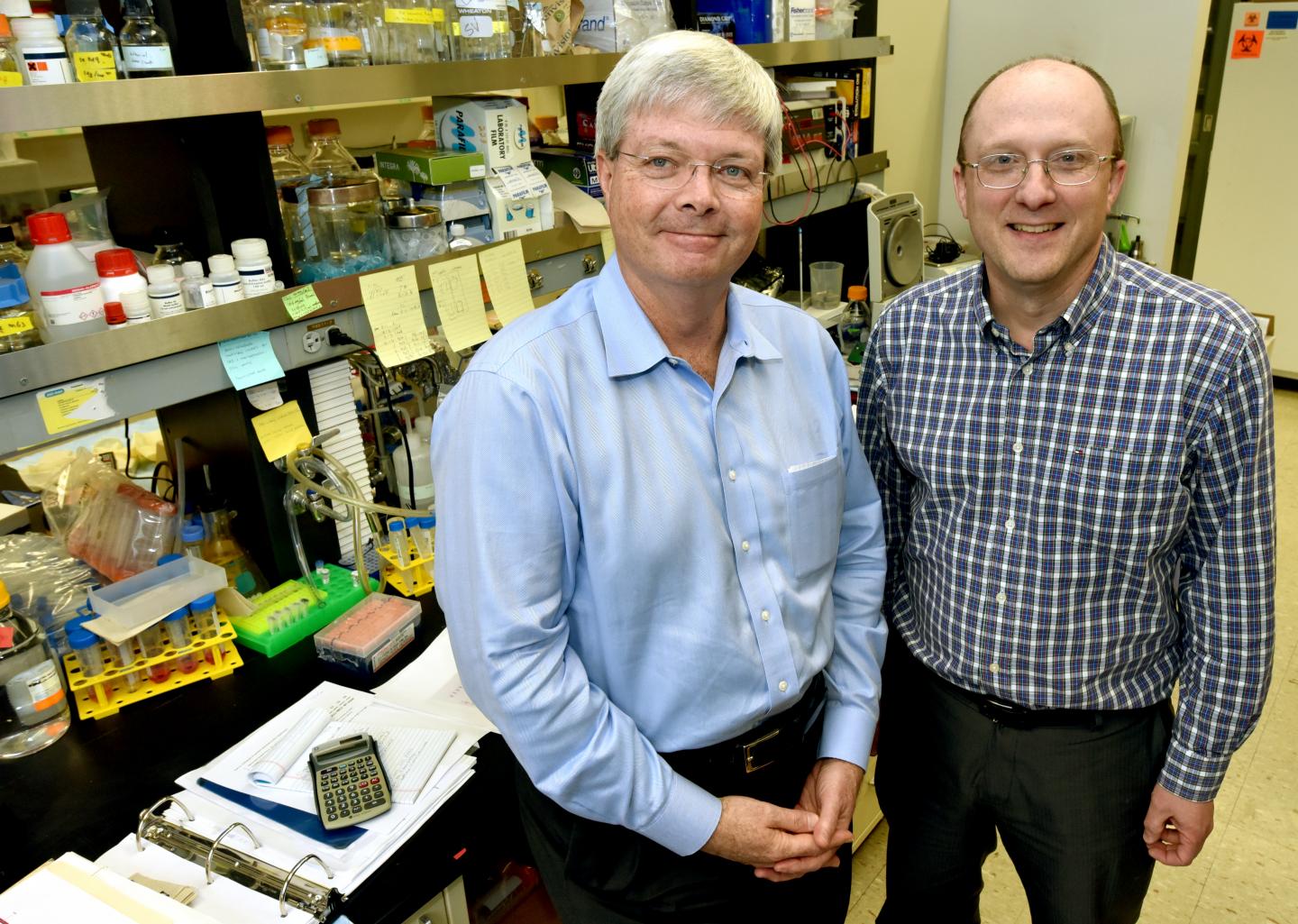
Herbert W. Virgin, MD, PhD (left), and Thad Stappenbeck, MD, PhD, have shown that mothers can pass a trait to their offspring through the DNA of bacteria. It's a firmly established fact straight from Biology 101: Traits such as eye color and height are passed from one generation to the next through the parents' DNA.
But now, a new study in mice by researchers at Washington University School of Medicine in St. Louis has shown that the DNA of bacteria that live in the body can pass a trait to offspring in a way similar to the parents' own DNA. According to the authors, the discovery means scientists need to consider a significant new factor - the DNA of microbes passed from mother to child - in their efforts to understand how genes influence illness and health.
The study appears online Feb. 16 in Nature.
"We have kept bacteria on one side of a line separating the factors that shape our development -- the environmental side of that line, not the genetic side," said co-senior author Herbert W. Virgin IV, MD, PhD. "But our results show bacteria stepping over the line. This suggests we may need to substantially expand our thinking about their contributions, and perhaps the contributions of other microorganisms, to genetics and heredity."
Bacteria are most familiar through their roles in harmful infections. But scientists have realized that such bacteria are only a tiny fraction of the bacterial communities that live in and on our bodies. Most bacteria are commensal, which means they do not cause harm and often confer benefits.
Commensal bacteria influence traits such as weight and behavior. But until now, researchers thought the bacteria that exerted these effects were acquired during a person's life. The study is the first to show that bacterial DNA can pass from parent to offspring in a manner that affects specific traits such as immunity and inflammation.
The researchers linked commensal bacteria in mice to the animals' susceptibility to a gut injury. Mice with certain inherited bacteria are susceptible to the injury, which is caused by exposure to a chemical. Female mice pass the bacteria to their offspring, making them vulnerable to the injury. Others carrying different bacteria are less susceptible.
In the short term, the findings may help scientists eliminate a significant "bug" in studies of genetically engineered mice. In several fields of research, scientists have been confronted intermittently with the sudden, unexplained appearance of new or altered traits in mice. The traits often spread from one mouse habitat to the next, suggesting a spreading microbial infection is responsible. But the traits also consistently pass from mother to offspring, suggesting a genetic cause.
Thaddeus Stappenbeck, MD, PhD, a professor of pathology and immunology, and co-senior author Virgin, the Edward Mallinckrodt Professor of Pathology and head of the Department of Pathology and Immunology, encountered this problem in their studies of inflammatory bowel diseases, such as Crohn's disease and ulcerative colitis. They were surprised to find that roughly half their mice had low levels in the gut of IgA, an antibody linked to these disorders.
IgA helps defend the body against harmful invaders. It is commonly present in mucus made by the body in areas where the exterior world encounters the body's interior, such as the eyes, nose, throat and gut.
When the scientists housed mice with low levels of the antibody with mice that had high levels of the antibody, all of the mice ended up with low antibody levels in a few weeks. When they bred the mice, the offspring whose mothers had low levels of the antibody also had low levels.
Eventually, the scientists learned that one of the culprits likely responsible for the spread of low antibody levels is a bacterium called Sutterella. This bacterium and others found in the low-IgA mice could explain both ways that decreased antibody levels were spreading: Mice that were housed together acquired low antibody levels through normal spread of the bacteria, and mouse mothers passed the same bacteria to their descendants.
The latter explanation involves a major change in thinking because it suggests that traits affected by bacteria can pass from mothers to their offspring in the same manner as traits affected by mouse DNA.
To prove that this change in antibody levels represented a significant change in the mice that could be thought of as a trait, the researchers fed the mice a chemical they use to characterize the gut's response to injury as part of their studies of inflammatory bowel diseases. In mice with low levels of the antibody, the compound caused much more damage.
"The implications for mouse experiments are profound and could help us cut through some persistent sources of confusion," Stappenbeck said. "When we study mice, we have to account for the possibility that inherited bacteria and their genes could be influencing the trait we're trying to learn about."
According to Stappenbeck, one way to do this will be to stop housing experimental and control mice in separate colonies. This would help ensure that any inherited microbes that influence a trait of interest are present in both groups.
In the long term, Virgin expects the expanded model of heredity to produce a more complicated but also much more insightful picture of how human, bacterial and viral genes influence human health.
Source: Washington University School of Medicine
 Print Article
Print Article Mail to a Friend
Mail to a Friend
